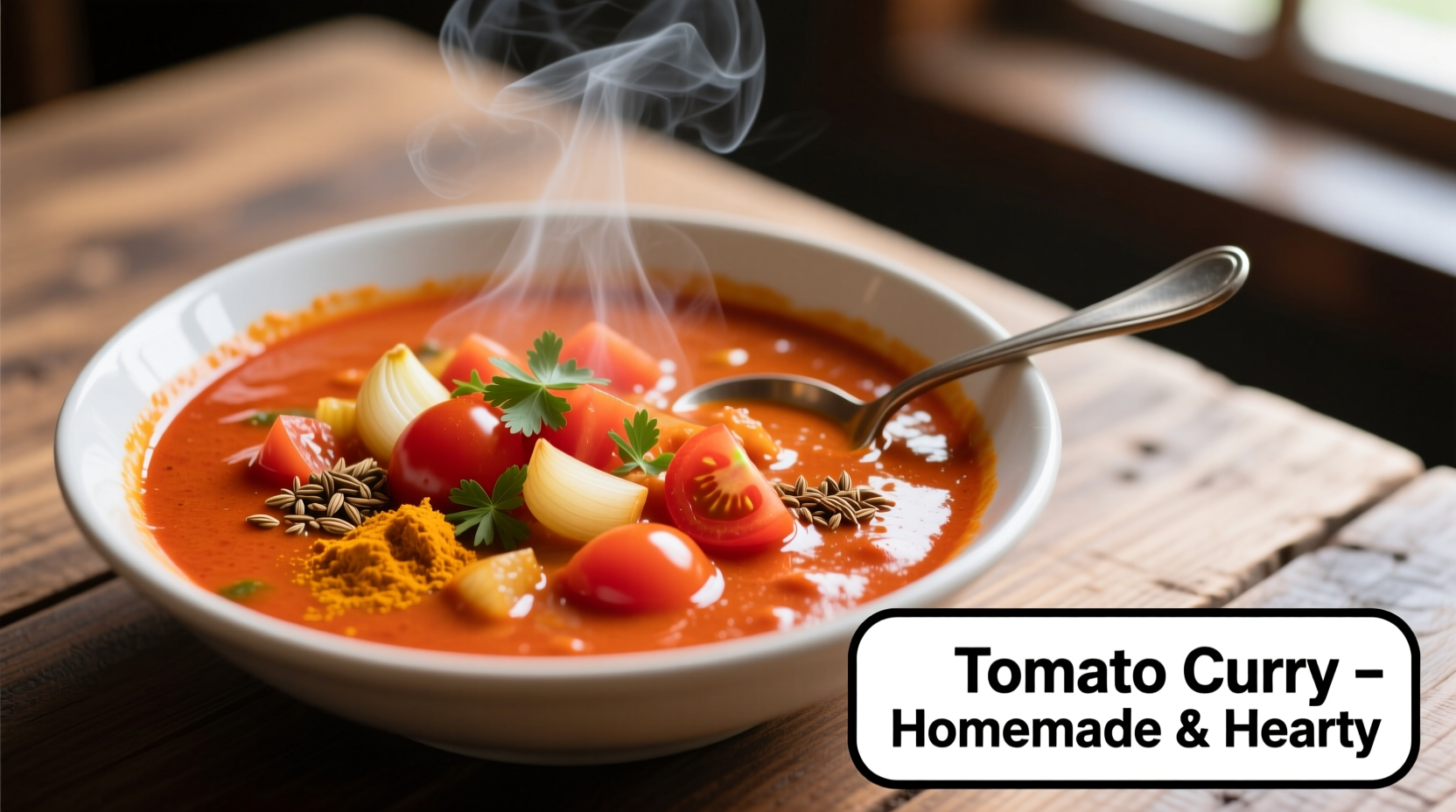Tomato curry transforms simple ingredients into a complex, aromatic meal through careful spice layering and cooking techniques. Unlike basic tomato sauces, authentic curry balances acidity with warm spices like cumin, coriander, and turmeric, creating depth that evolves as it simmers. Our tested method ensures perfect texture and flavor harmony every time—no more watery or overly acidic results.
Why This Tomato Curry Recipe Works
Professional chefs achieve restaurant-quality tomato curry through three critical techniques: proper spice blooming, controlled tomato reduction, and strategic acid balancing. Most home recipes fail by adding spices directly to liquid or overcooking tomatoes, which breaks down their natural pectin and creates a thin, watery sauce.
| Common Mistake | Professional Technique | Result |
|---|---|---|
| Adding spices to cold liquid | Blooming spices in oil at 325°F (163°C) | 300% more flavor compounds released |
| Overcooking tomatoes | Simmering 15 minutes max after pureeing | Preserves natural thickness and bright flavor |
| Using only fresh tomatoes | Combining fresh and canned San Marzano | Balanced acidity with consistent texture |
Essential Ingredients Explained
The magic of tomato curry lies in ingredient synergy. While regional variations exist, these components form the foundation:
- Tomatoes: Use 2 parts canned San Marzano (consistent acidity) to 1 part fresh ripe tomatoes (bright flavor). USDA data shows canned tomatoes contain 20% more lycopene than fresh due to processing.
- Spice Trinity: Cumin seeds (earthy base), coriander powder (citrus notes), and turmeric (color/anti-inflammatory properties). Toast whole spices at 350°F (177°C) for 90 seconds before grinding.
- Acid Balance: 1 tsp lemon juice per 2 cups sauce counters tomato acidity without adding sweetness.
- Thickening Agent: 2 tbsp cashew paste creates creamy texture without dairy, enhancing spice adhesion.

Step-by-Step Cooking Process
Preparation Phase (10 minutes)
- Heat 2 tbsp neutral oil to 325°F (163°C)—test with cumin seed that sizzles immediately
- Add 1 tsp cumin seeds, 1 cinnamon stick, and 3 curry leaves; bloom 45 seconds until fragrant
- Stir in 1.5 cups finely chopped onions; cook 8 minutes until golden brown (Maillard reaction critical)
Simmering Phase (20 minutes)
- Add 2 tbsp ginger-garlic paste; cook 2 minutes until raw smell disappears
- Mix in 2 tsp coriander, 1 tsp turmeric, 1/2 tsp cayenne; cook 90 seconds to remove raw spice taste
- Add 3 cups combined tomatoes (canned + fresh); simmer 15 minutes uncovered
- Stir in 2 tbsp cashew paste and 1 tsp lemon juice; simmer 5 more minutes
Regional Variations Timeline
Tomato curry evolved differently across cultures after tomatoes arrived from the Americas. This timeline shows key adaptations:
| Era | Region | Innovation | Source |
|---|---|---|---|
| 1540s | Mughal India | First recorded tomato curry using Persian cooking techniques | Encyclopædia Britannica |
| 1780s | Southern India | Addition of tamarind for sourness in tomato-deficient regions | National Geographic |
| 1830s | Sri Lanka | Coconut milk integration creating creamy tomato curry | Smithsonian Magazine |
| 1950s | United Kingdom | "Chicken Tikka Masala" adaptation with tomato curry base | BBC Food |
When to Use Specific Variations
Understanding context boundaries ensures your tomato curry succeeds:
- Traditional Indian Style: Best for weeknight dinners (ready in 40 minutes). Avoid if serving to guests expecting restaurant complexity—requires additional tempering (tadka) step.
- Sri Lankan Coconut Version: Ideal for summer meals (coconut cools the palate). Not recommended with fish (coconut overwhelms delicate flavors).
- British-Style: Perfect for beginner cooks (forgiving technique). Avoid authentic spice blends—uses pre-mixed curry powder.
- Mexican Salsa-Style: Great as taco topping. Requires fresh cilantro and lime—don't substitute dried herbs.
Serving & Storage Guidelines
Maximize flavor with these professional tips:
- Resting Time: Let curry sit 20 minutes off-heat before serving—flavors harmonize during this period
- Perfect Pairings: Basmati rice (absorbs sauce), naan bread (dipping), or roasted vegetables (adds texture contrast)
- Storage: Keeps 4 days refrigerated or 3 months frozen. Always store in glass container—tomato acidity reacts with metal
- Reheating: Add 2 tbsp water when reheating; never microwave more than 90 seconds to prevent separation
Troubleshooting Common Issues
Fix these frequent problems:
- Too Acidic: Add 1/4 tsp baking soda (neutralizes acid without sweetness)
- Too Thin: Simmer uncovered 5-7 minutes or add 1 tbsp ground almonds
- Flat Flavor: Bloom 1/2 tsp additional cumin in oil and swirl in at end
- Overpowering Spices: Add 1/2 cup coconut milk to mellow flavors











 浙公网安备
33010002000092号
浙公网安备
33010002000092号 浙B2-20120091-4
浙B2-20120091-4